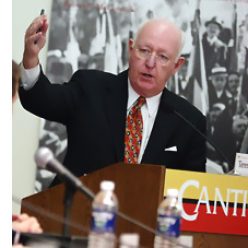AGASSI AGONISTES
Somehow, while I was looking the other way, Andre Agassi became the grand old man of professional tennis.
How did this happen? I still remember vividly the long hair, the denim shorts and the black shoes when Agassi won Wimbledon in 1992. I remember the blistering, two-handed service returns, the unbelievable quickness, the élan with which he attacked every game. That Andre. You know him. As entertaining a player as ever stepped on the court.
Now, suddenly, at the tennis-ancient age of 36, he has a bad back, drops out of tournaments, gets eliminated in the early rounds. The long hair has been replaced with a shaved head, the denim shorts by center-court white. With 60 singles titles to his credit, including eight majors, he has announced that the current U.S. Open — his 21st — will be his last competitive tournament. Andre, say it ain’t so.
The odds are against him as he takes on players little more than half his age. He struggled last night in a four-set opening match against Andre Pavel, but ultimately prevailed. Nonetheless, Agassi is the undisputed sentimental favorite of the over-the-hill gang, all of us older weekend players who choose to see a little of themselves in Andre and our own struggle against the clock. Tennis, after all, is a game where top players may peak in their 20’s, but many of us can play actively and enjoyably for decades more. Agassi isn’t alone at Flushing Meadows, he has the tennis geezers like myself rooting for him. Big time.
But Agassi represents something else as he approaches the end of his career. His departure marks the end of an era… the golden years when American players dominated the game. Over the last 20 years, there was always a Sampras or a Connors or a McEnroe or an Evert or a Williams sister in the finals. This year, no Americans got close to the finals at Wimbledon or the French open. The young hopefuls, like Andy Roddick and James Blake, gifted as they are, are struggling with their games, and the Williams sisters have been dogged by injury. The number one, Roger Federer, of Switzerland, aged 25, appears unbeatable. Behind him, Spain’s 20-year-old Rafael Nadal, is astonishing. The top women? They are all European and gorgeous and terrific. What they aren’t, is American.
What explains this drought? Is the American Century over? Is there some broader message here about American competitiveness in the 21st century? Some lack of moral fiber? Poor diet? Too many sugary drinks? Are we all fat and happy in our mediocrity?
I doubt it, but John McEnroe, who scores his points in the announcer’s booth these days, laments the trend and says he intends to reverse it by creating a top-quality training academy at the U.S. Tennis Center in Flushing Meadow, New York. It is not an entirely new idea, but he argues that American tennis has to draw talent from the big urban areas, from the masses, not just from the privileged who can afford to move the family, the Volvo station wagon and golden retriever to a high-priced boarding school-slash-tennis factory in Florida.
I think he is on to something and I hope it works. I am sure the American talent is there somewhere. In the meantime, I’ll be pulling for Agassi to overturn the odds and finish his career on a high note by beating some of the kids, maybe all of the kids. And I know I won’t be alone
